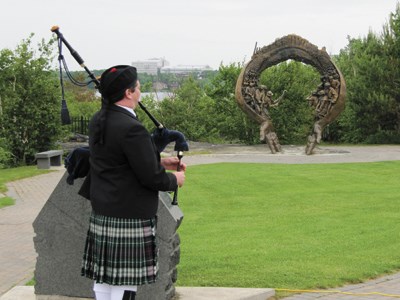The heart-pulling strains of “Amazing Grace” floated through the air at Bell Park Saturday morning as a bag pipe musician paid tribute to fallen miners.
The song was in remembrance of four workers who died after a seismic event at Falconbridge Mine on June 20, 1984.
A service was held under a tent near the Sudbury Mining Heritage Sculpture.
It was attended by about 70 people.
“It is fitting that we remember those killed on the job just as we do for victims of war,” said Mayor John Rodriguez.
At about 10:12 a.m,. 25 years ago, 200 miners were on shift at the mine when a seismic event, measuring 3.5 on the Richter Scale, struck. The major damage to the mine was between the 3,800-foot level and the 4,200-foot level.
During the first rescue attempts, a second seismic event occurred. The mine was evacuated and rescue operations ceased. Four miners were trapped. Around-the-clock rescue operations were begun, but Sulo Korpela, Richard Chenier, Daniel Lavallee and Wayne St. Michel passed away before they could be saved.
Former Falconbridge worker Brian MacDonald knew the deceased.
“Richard lived nearby to me. The others I talked to them all the time.
Everybody talked to everybody in those days,” he said.
He also knew those involved in the rescue effort.
“They (the rescuers) told me it was very, very scary. When it was all over, it affected them from the bottom of their hearts. Some were crying. They would shake when they spoke about it. They were down on their hands and knees digging.
“Alan Charbonneau (a first line supervisor) said that, when it was happening, the 12 by 12 (timbers) were snapping like toothpicks.”
Rick Grylls, retired president of Mine Mill Local 598/CAW, said he had only been a union officer for three days when the tragedy occurred. “The rock burst happened in my workplace.”
Grylls said St. Michel was alive for 27 hours. He passed away 15 minutes before rescuers could free him.
“The community prayed and hoped he would be rescued. When he died, a piece of all of us died,” said Grylls. After the losses, the union decided to begin a memorial day. The first one was held in 1985.
Grylls said the union pushed for better mine design to help prevent future problems.
“It meant a better understanding of ore removal from ore bodies. A (government) commission came out with a series of recommendations on how to redevelop and redesign mines after this rock burst and others.”
Marc Boissoneault, vice president Xstrata Nickel Sudbury operations, said zero harm in the workplace is definitely an achievable goal: “We are getting close to that all the time.”
Boissoneault said the reportable injury rate and lost time frequency rate have come down drastically at Xstrata operations in Sudbury during the last three years.
“The best example is the five million hours of no lost time at our new Nickel Rim Mine,” he noted.
John Closs, president of the Sudbury and District Labour Council, said health and safety has to be expanded.
“We are starting to move from injuries in the workplace to workplace illness and disease. (Now) we have to move towards harassment and violence in the workplace.”
Join Sudbury.com+
- Messages
- Post a Listing
- Your Listings
- Your Profile
- Your Subscriptions
- Your Likes
- Your Business
- Support Local News
- Payment History
Sudbury.com+ members
Already a +member?
Not a +member?
Sign up for a Sudbury.com+ account for instant access to upcoming contests, local offers, auctions and so much more.
